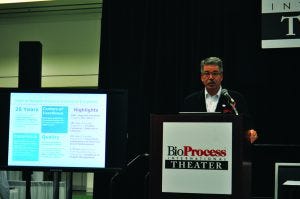Voices of Biotech
Podcast: MilliporeSigma says education vital to creating unbreakable chain for sustainability
MilliporeSigma discusses the importance of people, education, and the benefits of embracing discomfort to bolster sustainability efforts.
August 11, 2016
Sponsored by Catalent
Michael Merges (director of Catalent Biologics), BPI Theater @ BIO, June 8, 2016, 1:40–2:00 pm
 Many small companies do not have the expertise or specialized technologies to do the necessary testing that underlies biologics manufacturing. Expertise is needed in microbiology, raw materials testing, characterization, and method development. At the same time, testing is taking place earlier in product development. Bioassays are the most outsourced service, and that is expected to continue.
Many small companies do not have the expertise or specialized technologies to do the necessary testing that underlies biologics manufacturing. Expertise is needed in microbiology, raw materials testing, characterization, and method development. At the same time, testing is taking place earlier in product development. Bioassays are the most outsourced service, and that is expected to continue.
Catalent has over 25 years of experience in characterizing and testing biologics. The company employs more than 100 degreed scientists and offers a broad range of biologic analytical capabilities. Catalent can provide method development at any phase, method optimization and transfer, reference standard characterization, and phase-specific validation of all methods. It can provide all necessary testing as well.
Merges presented a case study of a bioassay development project involving a high-throughput process. The product was a hyperimmune serum for use by immune-compromised patients. The challenge was to rapidly (with two- to three-day turnaround) identify plasma donor samples that showed very high antibody titers. The client’s former process was complex, cumbersome, had low throughput, and took 10 days. The assay itself was prone to false positives and negatives. The client wanted a simpler and faster assay based on a recently published procedure. It had the concept of where it wanted to go but not the experience or resources to develop that assay or handle a high volume of testing.
Catalent focused on a fit-for-purpose solution, drafted multiple orthogonal approaches seeking simplicity and speed, and designed the assay to work in a high-throughput format. The assay itself uses RNA from cells and goes through a reverse transcription to form DNA. It involves fluorescent products that can be easily quantitated. The new assay comprises five tests (the former one comprised eight tests) and is rapid and efficient. Turnaround time went from 10 days to three days. False-positive and -negative results have been eliminated. The cost per sample was reduced from US$65 to $31. The final assay approach can measure 1,000 samples/week and is less labor intensive than the original. Catalent was able to collaboratively and rapidly provide what the client wanted.
Was the assay you developed specifically for this client, or can it be used by others? This is a platform assay that was designed specifically for one client. It was designed for one virus, but the company plans to use it across multiple virus types. But Catalent can take the same approach to develop assays for other clients.
How is the assay market changing and advancing? Bioassays used to be kept in-house; now they are outsourced more often. They are also being used much earlier in product development.
What should companies look for in an assay-developing partner? Look at the talent, expertise, breadth, and depth of the team as well as at cost effectiveness and efficiency.
Further Reading
Nims RW, Meyers E. Contractee Responsibilities in Outsourced Pharmaceutical Quality Control Testing. BioProcess Int. 8(5) 2010: 26–33.
Nims RW, Meyers E. Contractor Responsibilities in Outsourced Pharmaceutical Quality Control Testing. BioProcess Int. 8(6) 2010: 16–20.
Rios M. Outsourcing Stability Testing: Discussions with Contract Laboratories. BioProcess Int. 13(10) 2015: 16–21.
Ritter NM. Distinctions Between Analytical and Bioanalytical Test Methods. BioProcess Int. 9(3) 2011: 80.
Ritter R, et al. Bridging Analytical Methods for Release and Stability Testing: Technical, Quality and Regulatory Considerations. BioProcess Int. 14(2) 2016: 12–23.
Listen to the full presentation at www.bioprocessintl.com/BIO2016.
You May Also Like